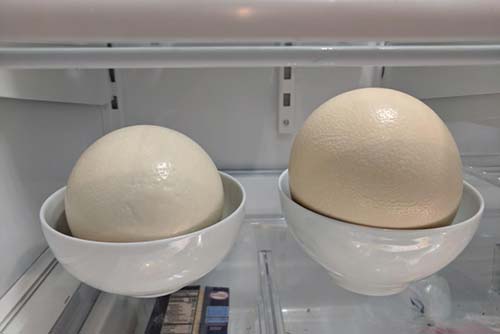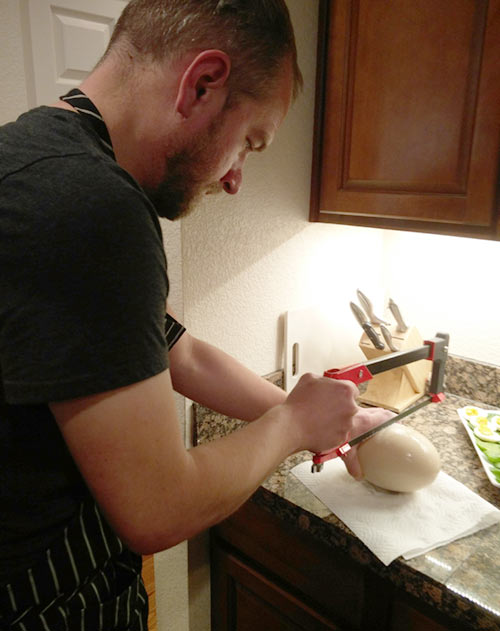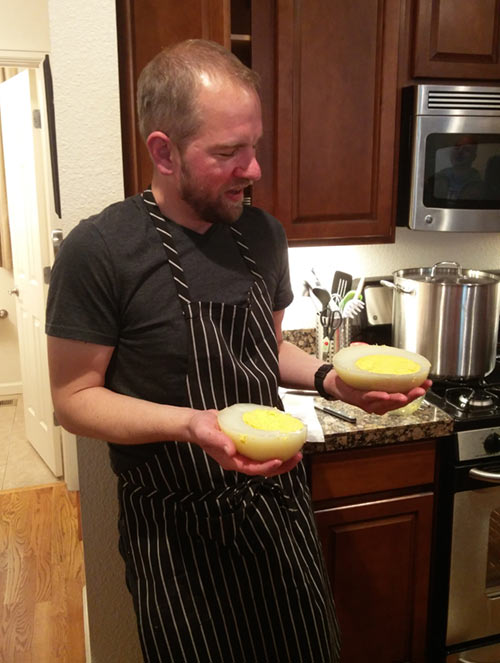Deviled ostrich egg
Five years ago, my efforts to hard boil an ostrich egg ended in undercooked disappointment. This year, I set out to correct that failure — and then some.
An ostrich egg is similar to a common chicken egg in many ways: there is a yolk; there is a white; and there is a shell composed mostly of calcium carbonate. The main difference is that it’s about two dozen times bigger. That size difference makes for appealing pageantry among the foodie set, of which I am an occasional interloper.
In 2013, I acquired a fresh ostrich egg over the internet, gathered a handful of friends one evening, and tried to hard boil the egg. Expectations were high as I sliced through the shell with a Dremel, but then: disaster. Beyond a thin outer layer of cooked egg white, we found little more than a sad, gloopy mess. The yolk wasn’t the least bit set. Lesson learned: an hour on the boil isn’t even close to enough time to hard boil an ostrich egg.
This year, I decided to try again. I resolved to taste naught but sweet success. Or savory success. Or whatever ostrich egg tastes like.
I ordered two fresh unfertilized ostrich eggs from Floeck’s in New Mexico. A couple days later, they arrived wrapped in layers of bubble wrap and really cute baby diapers. Even though they didn’t really require refrigeration — we refrigerate chicken eggs in America primarily because their natural protective coatings are usually stripped during processing — I stuck them in the fridge.

The two ostrich eggs in my refrigerator
Why two eggs? It’s not like one would have been insufficient, as they each had a mass of about 1.5 kg. Instead, I got two so that this time I’d have a “practice” egg. If I screwed that one up, perhaps by once again under-cooking it, I’d be able to recover with the second one.
The practice egg went into a pot of boiling water the night before I was going to have some friends over for brunch. After two hours on the boil, I removed the egg, gave it a spin, stopped the spin, and then let go again: the egg remained stationary. Had the egg resumed spinning, that would have indicated that liquid was still present inside, and so I would have cooked it some more. Instead, I plunged it into a cold ice bath while I got my hacksaw from the garage.
In a process that was repeated the next morning with the second egg, I sawed slowly around the circumference and chased the cut with a sharp knife to pierce the tough membrane that lined the interior of the shell. Then, slowly, I pulled off each end of the shell. A translucent white egg, gelatinous in appearance but firm in texture, was revealed.

Cutting a hard-boiled ostrich egg with a hacksaw (Photo credit: Dave)
Another cut was made, this one orthogonal to the saw line, splitting the egg into the two halves that are traditional for deviling.

Two halves of a hard-boiled ostrich egg (Photo credit: Dave)
From there, the deviling process was about the same as one would do if one were deviling chicken eggs: scoop out the yolk, mash in some mayo, brown mustard, garlic powder, cayenne pepper (dried), and Cholula (partially because of its acidity); put the mix into a piping bag; pipe back into the now-empty whites; and garnish with chives and paprika. For extra effect, I plated the eggs on beds of spinach leaves, which had the added benefit of keeping the eggs from sliding around.
My brunch guests and I agreed: ostrich egg tastes like chicken egg, perhaps ever so slightly “lighter”. And a deviled one? Heavenly.
Looks yummy! Did you consider using a sous vide cooker? It would have taken _much_ longer, but I imagine would have guaranteed a perfectly hard boiled egg.
@Travis
Hmm, can’t say I did. You’re probably right though. Maybe next time!